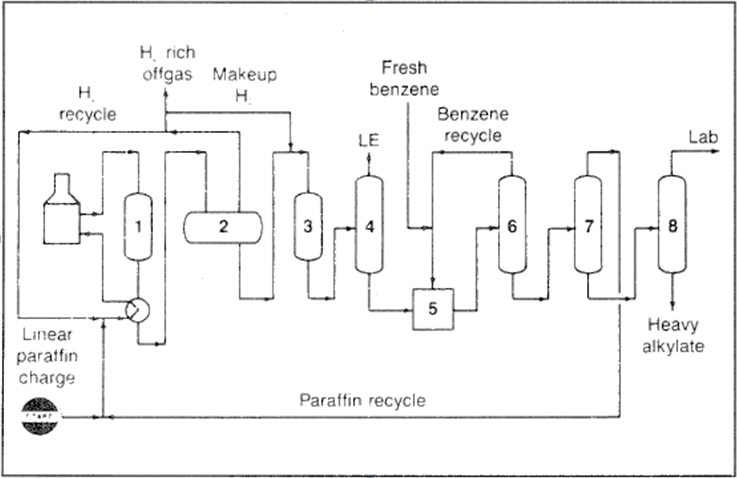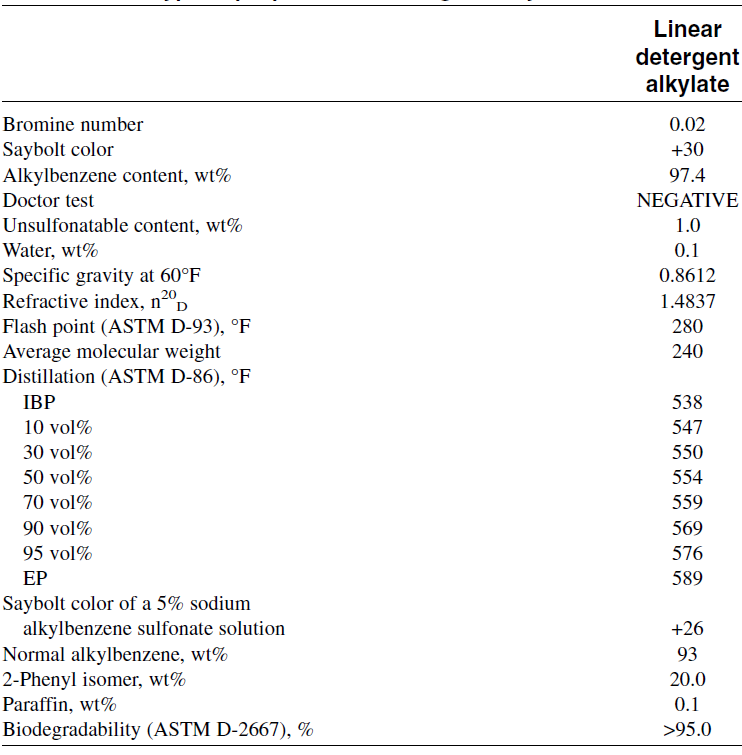
Linear Alkylbenzene
 المؤلف:
sami matar & Lewis. F. Hatch
المؤلف:
sami matar & Lewis. F. Hatch
 المصدر:
Chemistry of PETROCHEMICAL PROCESSES
المصدر:
Chemistry of PETROCHEMICAL PROCESSES
 الجزء والصفحة:
p 275
الجزء والصفحة:
p 275
 10-9-2017
10-9-2017
 2937
2937
Linear Alkylbenzene
Linear alkylbenzene (LAB) is an alkylation product of benzene used to produce biodegradable anionic detergents. The alkylating agents are either linear C12–C14 mono-olefins or monochloroalkanes. The linear olefins (alpha olefins) are produced by polymerizing ethylene using Ziegler catalysts or by dehydrogenating n-paraffins extracted from kerosines. Monochloroalkanes, on the other hand, are manufactured by chlorinating the corresponding n-paraffins. Dehydrogenation of nparaffins to monoolefins using a newly developed dehydrogenation catalyst by UOP has been reviewed by Vora et al.16 The new catalyst is highly active and allows a higher per-pass conversion to monoolefins. Because the dehydrogenation product contains a higher concentration of olefins for a given alkylate production rate, the total hydrocarbon feed to the HF alkylation unit is substantially reduced.
Alkylation of benzene with linear monoolefins is industrially preferred. The Detal process (Figure 1.1) combines the dehydrogenation of n-paraffins and the alkylation of benzene. Monoolefins from the dehydrogenation section are introduced to a fixed-bed alkylation reactor over a heterogeneous solid catalyst. Older processes use HF catalysts in a liquid phase process at a temperature range of 40–70°C. The general alkylation reaction of benzene using alpha olefins could be represented as:


Figure 1.1. The UOP (Detal) process for producing linear alkylbenzene: (1) pacol dehydrogenation reactor, (2) gas-liquid separation, (3) reactor for converting diolefins to monoolefins, (4) stripper, (5) alkylation reactor, (6,7,8) fractionators.
Typical properties of detergent alkylate are shown in Table 1.1.
Table 1.1 Typical properties of detergent alkylate

Detergent manufacturers buy linear alkylbenzene, sulfonate it with SO3, and then neutralize it with NaOH to produce linear alkylbenzene sulfonate (LABS), the active ingredient in detergents:

 الاكثر قراءة في البترو كيمياويات
الاكثر قراءة في البترو كيمياويات
 اخر الاخبار
اخر الاخبار
اخبار العتبة العباسية المقدسة


